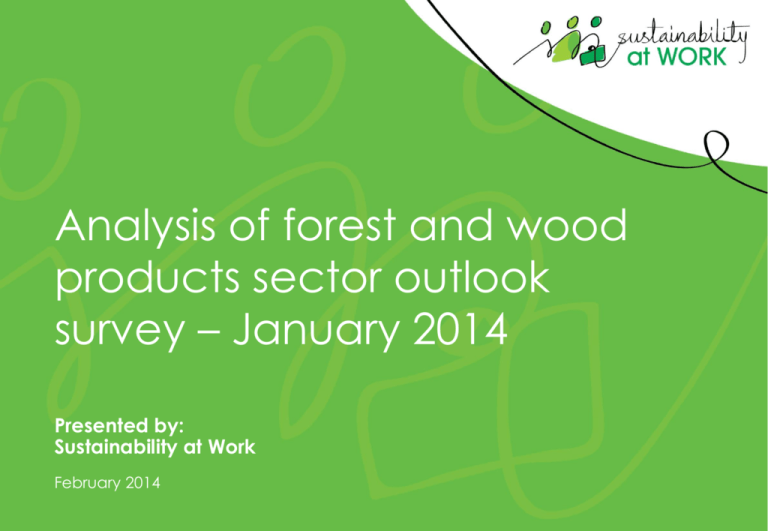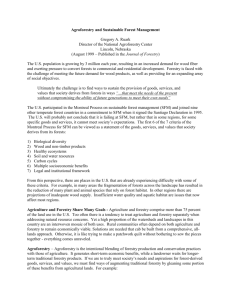here - Institute of Foresters of Australia
advertisement

Analysis of forest and wood products sector outlook survey – January 2014 Presented by: Sustainability at Work February 2014 Preamble The analysis of this research is conducted by Sustainability at Work on behalf of the Forest and Wood Products Australia (FWPA). • • All information in this report is strictly commercial in confidence and is copyright 2014 to FWPA. • Rounding of the data sets has been undertaken where only whole numbers are reported. • Sustainability at Work is a member of the Australian Social and Market Research Society (ASMRS) and thereby abides by the ASMRS Code of Conduct in relation to the analysis and reporting. Research Methodology • Online survey conducted between 15th and 29th Jan 2014. • The survey was distributed anonymously via FWPA and partner databases. • Total number of respondents n = 253. • Results are not statistically significant and are indicative of the opinions of the respondents only. Who responded to the survey? Knowledge of the forest & wood products industry What did they think about the future and what were the issues? Outlook for forest & wood sector Top 5 issues for the industry 1. 2. 3. 4. 5. Innovation in products and processes New investment Improvement in productivity Resource scarcity Increased domestic demand Note: Identified as having less of an impact were government regulation and green groups. Importance of issues for the industry 5 4.5 4 3.5 3 2.5 2 1.5 1 0.5 0 Importance of issues by knowledge Little Reasonable Lots Total 4.33 4.15 4.44 4.26 Innov'n in prd/process 4.2 4.35 4.38 4.35 Improved productivity 4.13 4.23 4.27 4.23 3.6 3.99 4.25 4.04 Inc domestic demand 4.07 4.08 4.22 4.12 Resource security 4.53 4.07 4.12 4.13 Foreign exchange rate 3.2 3.85 4.1 3.87 4 3.91 4 3.95 Labour costs 3.6 3.77 3.98 3.82 Social licence 3.87 3.89 3.96 3.91 4 3.82 3.96 3.88 Inc in export demand 3.67 3.69 3.82 3.73 Inc collaboration 3.87 3.76 3.78 3.78 Inc in plantation estate 3.93 3.72 3.78 3.76 Govt regulation 3.73 3.81 3.69 3.76 Chg Fed govt leg 3.64 3.8 3.69 3.75 Actions green groups 3.67 3.56 3.67 3.6 Chg to state govt leg 3.8 3.81 3.63 3.75 Tax & govt charges 3.47 3.4 3.61 3.47 New investment Better mkt price Those with lots of knowledge had greatest deviation from rest with • new investment • increase in domestic demand • better market price • foreign exchange Workforce skills Energy costs Unprompted top 5 issues vs prompted issues Priority Prompted Top 5 Issues Unprompted Top 5 Issues 1 Innovation in products or processes Innovation in products or processes 2 New investment Resource scarcity 3 Improvement in production Workforce skills 4 Resource scarcity Competition* 5 Increased domestic demand Increased domestic demand * This was an additional category added for unprompted Unprompted issues 16% 14% 12% 10% 8% 6% 4% 2% 0% Additional Issues Verbatim Quotes “There is a clear need to improve how forest industry advocacy is done in Australia - there are too many organisations which require large subscriptions in order to stay afloat at a base level, let alone have any substantial influence - need more services for the total fee base.” “Most people think the forestry sector is about trees. The industry has not understood macro economics, resources and the wider national interest. If it did, it would be in the top 5 industries demanding productive, competitive, sustainable management policies. These are not of concern to the industry and others, because Australians must survive in the ridiculous high cost country environment. We all, including foresters, accountants and governments are hooked up in the unproductive high cost non-viable economic scenarioThe forestry industry needs to adopt a totally new whole of industry resources approach.” Q15. One thing you would change to improve the industry Q15. One thing you would change to improve the industry - verbatim “A shared vision and leadership aligned to this that is globally aware, market growth orientated and enthusiastic about the role & value of science and innovation for the sector.” “Improved community and environmental movement perception of forestry and the forest industry, leading to a more positive operating environment for forestry - the things that follow are better research support, more opportunities for participation in environmental solutions and more interest from people in involvement in the forest industry.” “Develop more value chain oriented thinking within sectors - work collaboratively to foster highest & best uses for all fibre outputs - with the focus on getting the most (collective) returns - then allocate returns within the chain. The present arrangements have led to sub-optimal outcomes.” Q15. One thing you would change to improve the industry Q17. What can be done to improve the international competitiveness of the Australian forest and wood products sector? Q17. What can be done to improve the international competitiveness of the Australian forest and wood products sector? Verbatim “Amalgamate industry representative bodies under a single umbrella and use resources to lever Government funds to establishing a National Research Education and Training centre. A Centre that does the work rather than fund a myriad of other agencies to do the work.” “Stable AUD, increased and stable quality backed up with excellent technical service. A deeper understanding of the real needs of the consumer sectors and product development driven by real needs on the local target market, only develop where sustainable competitive advantages can be identified and exploited --> needs based R&D. Explore new business models and operating approaches which work on collaboration and sharing the gains approach.” “The industry needs to take advantage of the superior qualities of Australian hardwood species to develop high-value, niche products for the domestic and export markets (instead of "wasting" the resource by using it for sleepers, etc). these could be incorporated into innovative building systems that drive demand for timber and wood products.” “Increased research in genetics (GE not GM), best practice, precision silviculture, and 'high tech' timber products (eg CLT). Increased foreign aid to help provide alternatives to communities dependent on illegal forestry practices, and removing these cheap illegal products from market. Increased certification.” Industry leading organisations 18. What are the 5 most influential organisations in the Australian forest & wood products sector – unprompted? 1. 3. 2. 4. Top 6 INFLUENTIAL organisations (from list - prompted) by knowledge level FWPA Reas. AFPA EWPAA VAFI CFMEU AWU Lots Reas. Lots Reas. Lots Reas. Lots Reas. Lots Reas. Lots 1– 3% least 3% 0 4% 3% 9% 3% 6% 4% 2% 11% 13% 2 12% 17% 15% 7% 10% 17% 20% 17% 16% 18% 23% 29% 3 27% 24% 28% 35% 24% 30% 24% 33% 22% 38% 27% 24% 4 31% 26% 34% 28% 20% 22% 19% 22% 27% 20% 11% 16% 524% most 30% 13% 17% 4% 2% 4% 9% 19% 13% 10% 2% DK 0 10% 9% 39% 20% 30% 13% 12% 9% 18% 16% 3% 20. When thinking about an organisation's influence, what are the criteria that come to mind? 20. What are the criteria that come to mind? Verbatim “Important to have a unified approach, consider pooling resources and research topics, have both technical research & development and market needs analysis connected closer. Increase international collaboration both with external R&D and also from Government support level assist in development of Innovation Parks, i.e Building Research Establishment UK development of Innovation Parks in Beijing and Rio, supporting UK business to expand and develop its business overseas. In the construction sector, greater influence on building performance and standards to facilitate the use of better performing building materials. Support the development of exportable industry standards and building systems especially to the developing World.” “Market share, capacity to influence forestry through policy decisions (e.g. tax deductibility of planting costs), multi State presence, active in domestic and international markets, disproportionate influence on forest and wood products investment.” “Influence on government policy, public awareness and profile, progress achieved on issues. Support provided to the industry as a whole.” “Promotion, research, information sharing, social influence, professional information gathering and source” Membership by knowledge of industry Members of FWPA Little Reasonable Lots Yes 36% 46% 56% No 27% 52% 44% DK 37% 2% 0% Members of IFA Little Reasonable Lots Yes 0% 39% 59% No 64% 56% 36% DK 36% 5% 5% FWPA and IFA were the only two organisations that had significant membership. IFA however was rated very low on influence. Next closest membership was AFPA with 30%+ and Forestworks with 20+%. Training and Expenditure Training Focus in Next 12 Months • General comments reflect a need to implement across the board from basic literacy and numeracy, practical and OWS, to business skills, to systems, to leadership. • 23% said there would be more spent on training with over half saying training expenditure will stay the same. Training Focus - verbatim • “Systems and administration -Market forecasting, Logistics and Production scheduling” • “Legislative training Professional development” • “More closely aligned with business needs.” • “OH&S , Middle management, supervisor training” • “Harvesting; safety; wildlife management; compliance” • “Basic literacy, numeracy skills” • “Focus on young staff for future Management roles” • “Biomass opportunities, for example cellulosic bio materials and bio energy derived from wood” • “General upskilling of most persons to allow flexibility throughout the workforce. New systems implementation will require training to support and operate them” Capex in the next 12 months Capex in next year by knowledge Levels of Capex in the next 12 months Levels of Capex by knowledge






